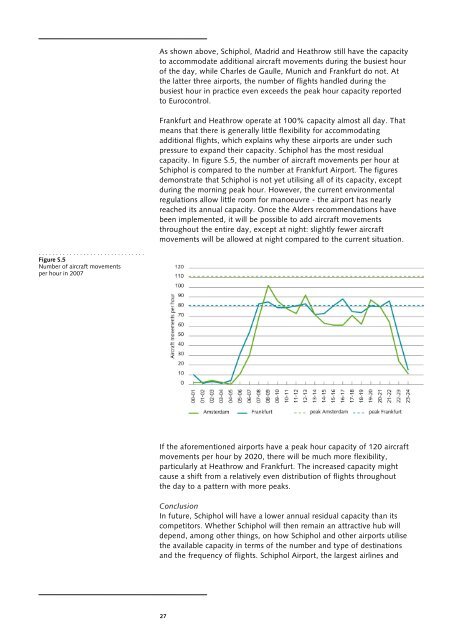Internationale benchmark capaciteit luchthavens - Kennisinstituut ...
Internationale benchmark capaciteit luchthavens - Kennisinstituut ...
Internationale benchmark capaciteit luchthavens - Kennisinstituut ...
Create successful ePaper yourself
Turn your PDF publications into a flip-book with our unique Google optimized e-Paper software.
. . . . . . . . . . . . . . . . . . . . . . . . . . . . . . .<br />
Figure S.5<br />
Number of aircraft movements<br />
per hour in 2007<br />
As shown above, Schiphol, Madrid and Heathrow still have the capacity<br />
to accommodate additional aircraft movements during the busiest hour<br />
of the day, while Charles de Gaulle, Munich and Frankfurt do not. At<br />
the latter three airports, the number of flights handled during the<br />
busiest hour in practice even exceeds the peak hour capacity reported<br />
to Eurocontrol.<br />
Frankfurt and Heathrow operate at 100% capacity almost all day. That<br />
means that there is generally little flexibility for accommodating<br />
additional flights, which explains why these airports are under such<br />
pressure to expand their capacity. Schiphol has the most residual<br />
capacity. In figure S.5, the number of aircraft movements per hour at<br />
Schiphol is compared to the number at Frankfurt Airport. The figures<br />
demonstrate that Schiphol is not yet utilising all of its capacity, except<br />
during the morning peak hour. However, the current environmental<br />
regulations allow little room for manoeuvre - the airport has nearly<br />
reached its annual capacity. Once the Alders recommendations have<br />
been implemented, it will be possible to add aircraft movements<br />
throughout the entire day, except at night: slightly fewer aircraft<br />
movements will be allowed at night compared to the current situation.<br />
If the aforementioned airports have a peak hour capacity of 120 aircraft<br />
movements per hour by 2020, there will be much more flexibility,<br />
particularly at Heathrow and Frankfurt. The increased capacity might<br />
cause a shift from a relatively even distribution of flights throughout<br />
the day to a pattern with more peaks.<br />
Conclusion<br />
In future, Schiphol will have a lower annual residual capacity than its<br />
competitors. Whether Schiphol will then remain an attractive hub will<br />
depend, among other things, on how Schiphol and other airports utilise<br />
the available capacity in terms of the number and type of destinations<br />
and the frequency of flights. Schiphol Airport, the largest airlines and<br />
27




